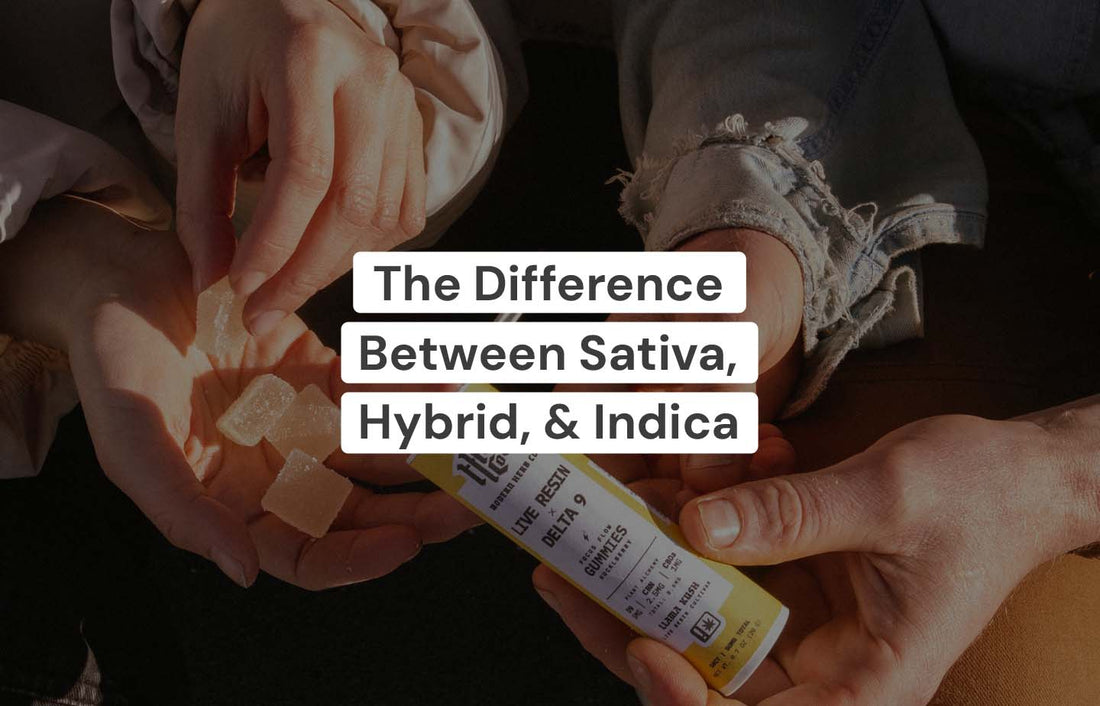
The Difference Between Sativa, Indica, And Hybrid
If you’ve ever spent much time perusing the various products offered by cannabis retailers, you may have been overwhelmed by all the different options available to consumers today. With all of the various cannabis strains and product types, it can be difficult to determine what each product has to offer and how it will affect you. One of the first things you might notice is that many cannabis and hemp products are marketed as being sativa, indica, or hybrid. But what do these terms mean and how can they help you choose products that are right for you? The general idea behind classifying cannabis strains as either sativa, indica, or hybrid is that each group has different psychoactive effects compared to the others. Thanks to the ingenuity and dedication of breeders over generations of weed agriculture, there are hundreds (if not thousands) of different types of cannabis, commonly referred to as strains, cultivars, varietals, or phenotypes. Luckily, nearly all of these strains fall under one of three broad categories: sativa, indica, and hybrid, with each type having particular characteristics in common, including overall psychoactive effect and plant morphology (size and shape). Additionally, the three strain types all have palm-shaped leaves with serrated edges that are ubiquitous in cannabis culture and lore, although each has distinctive details. Classifying cannabis strains as either sativa, indica, or hybrid, however, isn’t a perfect system for several reasons that will be explored, and there are better ways to classify strains based on their cannabinoid and terpene profiles.
Table of content
Why It Sucks?
Although classifying cannabis strains as either sativa, indica, or hybrid is popular with marketers and many consumers, the system has many drawbacks. With more than 100 distinct cannabinoids and an equal number or more of different terpenes that can be found in cannabis, it’s just too simple an approach for the amazing diversity inherent to the plant. Additionally, because the legalization of cannabis has occurred primarily over just the past couple of decades, research into the plant and its benefits has been stymied. We are learning more and more about cannabis seemingly every day, and systems to understand the plant’s diversity and varying effects should account for such complexity. For example, there is still debate about the taxonomic classification of cannabis. Many researchers group all strains of hemp and cannabis together as the species Cannabis sativa. Others see the differences between plants found in different parts of the world as three distinct species or subspecies: Cannabis sativa, Cannabis indica, and Cannabis ruderalis, a short, stocky plant that is not dependent on long nights to flower. Because cannabis research has been limited by prohibition, there is still much to learn about the plant, including the ongoing discovery of compounds the plant contains. There are many factors behind the effects of a particular strain, some known and some still to be learned. For example, the different cannabinoids and terpenes can work together synergistically, providing a total effect that exceeds the sum of its parts. Another fact to consider is that nearly all commercially available strains are truly hybrids. Hardly any pure sativa or indica cultivars, sometimes called landraces, are available to consumers. Cannabis genetics have been shared around the world, making it more and more difficult to find cultivars that are purely sativa or indica. Additionally, as strains get passed from grower to grower, the names of cultivars can get confused or strains can be given new names. Taken together, these factors make the genetic history of most cultivars murky at best.
Something is Better Than Nothing
Despite the drawbacks, classifying cannabis strains as either sativa, indica, or hybrid can have some value. A better system would rely more on the combination of cannabinoids and terpenes of a particular strain, which can be determined from laboratory analysis. Consumers have access to the results of such testing by reviewing or requesting a certificate of analysis (COA) from the retailer. Using the COA, you can determine which predominant cannabinoids and terpenes are in strains that you like and begin to understand what works for you. Using this information can help guide future purchases to help you find the effect you are looking for. It is also important to remember that every person is different, so personal experience is also key to obtaining the best results from the cannabis you buy.
Sativa
Sativa strains of cannabis are believed to have originated in countries with warm equatorial climates such as Mexico, Colombia, Thailand, and Southeast Asia. Sativa plants grow tall and conical, giving them a Christmas tree-like appearance. Sativa strains are generally considered to produce more of a head high than a body high, meaning they stimulate your mind, creativity, and focus without leaving you feeling heavy or sleepy. They are known for their energizing and uplifting effects that can help reduce feelings of lethargy and apathy, making them perfect for daytime or social situations. Sativas can also stimulate focus, so they can be a great choice for creative pursuits. Some people report that sativa strains of cannabis can ease anxiety with soothing and uplifting effects and that it helps them eliminate repeated or intrusive thoughts.
Old-School Sativa Strains
- Maui Wowie, also known as Maui Waui or Mowie Wowie, is a sativa cannabis strain that originated in Hawaii in the 1960s. It produces medium-dense buds, coated with frosty, resinous trichomes. Maui Wowie has a citrus, earthy, fruity, and sweet smell. The taste is sweet, tropical, citrus, pineapple, and fruity. The strain is generally known for its uplifting and energetic effects that can induce a sense of euphoria and creativity while keeping the user focused and alert. It is also known to have stress-relieving qualities.
- Durban Poison is a pure sativa strain originating from the South African port city of Durban. The uplifting and energizing effects of Durban Poison make it a great choice for creative pursuits, outdoor activities, or staying productive throughout the day. The strain can be quite potent, with THC levels of 25% or more sometimes reported.
- Jack Herer is a sativa cannabis strain named after the legendary cannabis activist and author of “The Emperor Wears No Clothes.” The strain has a citrus, spice, and pine aroma and flavor. Jack Herer is known for its potent medical properties and is often used to treat stress, anxiety, and depression. The popular strain is also known for its energizing and uplifting effects, making it a popular choice among cannabis consumers. It has a THC potency of 18% or higher.
- Sour Diesel is a sativa cannabis strain that originated in the 1990s on the East Coast of the United States. The strain has a pungent flavor profile that smells like diesel, with hints of citrus, spice, and pine. Sour Diesel is known for its fast-acting and energizing effects, which are dreamy and cerebral. It has a THC potency of about 19% and negligible amounts of CBD. Medical cannabis patients choose Sour Diesel to help relieve symptoms associated with depression, pain, and stress.
Indica
Indica strains of cannabis are believed to have originated either on the Asian subcontinent or in Afghanistan. The first European botanist to classify this type, Jean-Baptiste Lamarck, received his samples from India leading him to classify the plant as Cannabis indica. Indica strains mainly came to the West from India, Nepal, Afghanistan, and Northern Pakistan during the 1970s, particularly from the Hindu Kush mountain range. The plants of indica strains of cannabis are characterized by their short and compact stature, with a bushy appearance and broad, dark-green leaves with wide leaflets. The effects of indica strains of cannabis are generally considered to be relaxing and calming, which can help reduce stress, anxiety, and pain. They can also cause sedation and sleepiness, making them ideal for nighttime use. Indica strains are often associated with an intense body high that can lead to feelings of heaviness or lethargy, sometimes referred to as “couch lock.” The intensity and duration of these effects can vary depending on the cultivar, the THC and CBD content, and the consumer’s history with cannabis. As always, it is important to note that the effects of cannabis can vary widely from person to person, and some people may experience negative side effects such as paranoia or anxiety.
Old-school Indica Strains
- OG Kush is an indica cannabis strain that is believed to be a cross between Chemdawg and Hindu Kush or Old World Pakistani Kush. The strain is known for its dense, resinous buds that are covered in shiny trichomes. OG Kush has a complex aroma with notes of fuel, skunk, and spice. OG Kush has calming and energizing effects, which can help relieve stress, anxiety, and pain. The THC content of the strain ranges from 18% to 28%.
- Northern Lights is one of the most famous strains of all time and is believed to be descended from Afghani and Thai landrace strains. The varietal produces euphoric effects throughout the body, relaxing muscles and easing the mind. Northern Lights is known for producing resin-coated buds that are densely clustered, and at times can have a slightly purple hue. Its pungent aroma is described as earthy or piney, and it has a sweet or fruity flavor. Medical cannabis patients choose Northern Lights to help relieve symptoms associated with depression, stress, pain, and insomnia.
- Romulan is an indica cannabis strain that is believed to be a cross between North American Indica and White Rhino. When smoked, the strain delivers a powerful body high that can help alleviate pain and stress. The buds of Romulan are dense and resinous, with a strong piney smell and notes of earth and citrus. The cultivar is also known for its potent and therapeutic qualities and is used by medical cannabis patients to treat symptoms related to muscle spasms and nerve damage.
- Bubba Kush is an indica strain that is known for its heavy tranquilizing effects and sweet hashish flavors with subtle notes of chocolate and coffee. The plant has a stocky stature and bulky bud structure, suggesting Afghani descent. Bubba Kush’s buds are compact and sparkle with resin, with hues that range from forest green to pale purple. The strain is considered relatively easy to cultivate, making it a suitable option for beginner growers or those who are just experimenting with raising one plant.
Hybrid
Talented plant breeders around the world have produced hybrid strains of cannabis by crossing sativa strains with indicas to produce new cultivars that incorporate traits from both groups. As mentioned previously, nearly all of the strains available today are actually hybrids that have genes from both sativas and indicas. The effects of hybrid cannabis cultivars depend on the particular mix of parent genetics and can vary widely. The effects of hybrid strains can range from reducing anxiety and stress to easing symptoms of chemotherapy or radiation, relaxing, aiding in sleep management, energizing to help with fatigue, treating acute pain, reducing nausea, muscle relaxation, and stimulating appetite.
Old-school Hybrid Strains
- Skunk #1 is a hybrid marijuana strain that has influenced cannabis on a global scale, parenting a multitude of Skunk crosses since it was first hybridized in the late 1970s. Skunk #1 was created using diverse genetics from around the world including Afghani, Acapulco Gold, and Colombian Gold varieties. The strain was created through an intricate selective breeding process that spanned several generations. The cultivar has itself been used as a parent of countless other cannabis hybrids over the years. Skunk #1 buds radiate with an aromatic blend of sour skunkiness and subtle earthy notes. This hybrid offers elevated creativity through its high-energy buzz.
- AK-47 is a sativa-dominant hybrid cannabis strain that is a blend of Colombian, Mexican, Thai, and Afghan strains. It has a high THC content and is known for inducing calm and happy feelings, and in some cases, deep couch lock. AK-47 is a top pick for recreational consumers and people with physical and mental ailments due to its high THC levels and moderate CBD content.
- Blue Dream is a sativa-dominant hybrid marijuana strain that is a cross between Blueberry and Haze. It is one of the most popular cannabis strains in the world, known for its balanced high and cerebral stimulation. Blue Dream generally has a THC content of 18% with little CBD, making it a favorite among both novice and veteran cannabis consumers. Blue Dream is reported to smell and taste like sweet berries. Medical cannabis patients often use Blue Dream to treat symptoms of depression, chronic pain, and nausea.
- White Widow is a hybrid cannabis strain that was created in the Netherlands by crossing a Brazilian sativa and a South Indian indica and is one of the most popular and famous strains in the world. It is known for its high resin production, white trichomes, and potent effects. White Widow buds are covered in glistening trichomes that provide a powerful burst of euphoria and energy, stimulating both conversation and creativity. Medical cannabis patients often choose White Widow when dealing with symptoms associated with stress, anxiety, and pain.
Conclusion
Cannabis and hemp strains can be classified into three different categories based largely on their effects and plant morphology: sativa, indica, or hybrid. While not perfect, the system can help consumers get a general idea of a cannabis cultivar’s effects. Sativa strains are generally considered to produce more of a head high than a body high, meaning they stimulate your mind, creativity, and focus without leaving you feeling heavy or sleepy. They are known for their energizing and uplifting effects that can help reduce feelings of lethargy and apathy, making them perfect for daytime or social situations. Sativas are known for their tall, conical plant structure with narrow leaflets and long flowering cycles. Sativa strains of cannabis are believed to have originated in countries with warm equatorial climates such as Mexico, Colombia, Thailand, and Southeast Asia. Popular classic sativas include Durban Poison, Maui Wowie, and Jack Herer. Indica strains of cannabis are known for their usually relaxing and calming effects, which can help reduce stress, anxiety, and pain. They can also cause sedation and sleepiness, making them ideal for nighttime use. Indica strains are generally associated with an intense body high that can lead to feelings of heaviness or lethargy, sometimes referred to as couch lock. The plants of indica strains of cannabis are characterized by their short and compact stature, with a bushy appearance and broad, dark-green leaves with wide leaflets. Some of the most popular indicas include OG Kush, Northern Lights, Bubba Kush, and Romulan. Hybrid strains are created by breeders who cross indica and sativa parents to produce new cultivars. Because they have genes from both lineages, the psychoactive effects can vary greatly, ranging from calming and relaxing to uplifting and energizing. Old-school hybrid strains include Skunk #1, AK-47, and Blue Dream. Although whether a cannabis cultivar is an indica, sativa, or hybrid can serve as a guide to its effects, there are better ways to shop to achieve the desired effect. Consumers can better determine which strains are good for them by reviewing laboratory COAs for cannabinoid and terpene content. As they try different strains and decide what they like, they can then choose other varieties with similar cannabinoid and terpene combinations. Although the sativa, indica, or hybrid system of classifying cannabis varietals is too simple and a tad lazy given the extreme diversity of cannabis strains and their effects, it can serve as a guide while more is learned and a better system is developed. Until then, consumers can help inform their own decisions and spur innovation in the industry by requesting a COA for each strain they try to determine which cannabinoid and terpene combinations work best to achieve the desired effect.
FREQUENTLY ASKED QUESTIONS
What is the difference between sativa, hybrid, and indica?
The differences between the groups of cannabis strains are based on their origin and overall psychoactive effects. Plant morphology can be an indicator of the group, with sativas growing tall and conical and indicas shorter and bushier.
What are the origins of sativa, indica, and hybrid?
Sativa strains of cannabis are believed to have originated in countries with warm equatorial climates such as Mexico, Colombia, Thailand, and Southeast Asia. Indica strains mainly came to the West from India, Nepal, Afghanistan, and Northern Pakistan during the 1970s, particularly from the Hindu Kush mountain range. Because they are a mix of sativa and indica, hybrid strains have genetics from both groups and are created by talented breeders around the world.
What are the effects of sativa strains of cannabis?
Sativas are generally known for their energizing and uplifting effects that can help reduce feelings of lethargy and apathy, making them perfect for daytime or social situations. They are generally considered to produce more of a head high than a body high, meaning they stimulate your mind, creativity, and focus without leaving you feeling heavy or sleepy.
What are the effects of indica strains of cannabis?
Indica strains of cannabis are known for their usually relaxing and calming effects, which can help reduce stress, anxiety, and pain. They can also cause sedation and sleepiness, making them ideal for nighttime use. Indica strains are generally associated with an intense body high that can lead to feelings of heaviness or lethargy, sometimes referred to as couch lock.
What are the effects of hybrid cannabis strains?
Because they have genes from both indicas and sativas, the psychoactive effects can vary greatly, ranging from calming and relaxing to uplifting and energizing.
What are the most popular sativa strains?
Popular classic sativa strains include Durban Poison, Maui Wowie, Sour Diesel, and Jack Herer.
What are the most popular indica strains?
Indicas that pass the test of time include OG Kush, Northern Lights, Bubba Kush, and Romulan.
What are the most popular hybrid strains?
Old-school hybrids include Skunk #1, AK-47, White Widow, and Blue Dream.
How do I choose the right strain for me?
Although whether a particular cannabis strain is a sativa, indica, or hybrid can give some clues to its psychoactive effects, it’s not the best way to make shopping decisions. A better method is to learn the cannabinoid and terpene contents of strains you like by studying COAs from your favorite cultivars and then using the information to help guide your purchases to achieve the desired effects."
Related Post

About Ashley Dellinger
Ashley Dellinger is a trailblazer in the cannabis and hemp sectors, serving as the Director of Innovation at The Hemp Collect. With a keen visionary mindset, she not only propels advancements in these industries but also showcases her versatility as a seasoned professional writer based in Oregon. As a collaborative force, Ashley works alongside leading brands, processors, and retailers to elevate industry standards. Ashley Dellinger's work not only sets new benchmarks but also inspires others to pursue excellence. For a closer look into her insights and experiences, connect with Ashley on LinkedIn, Instagram, and Facebook.



















